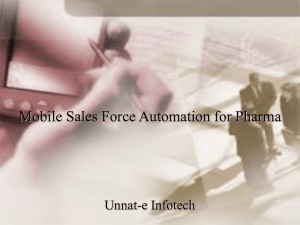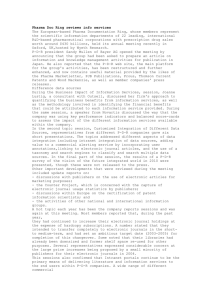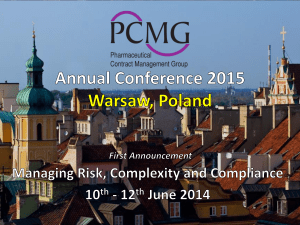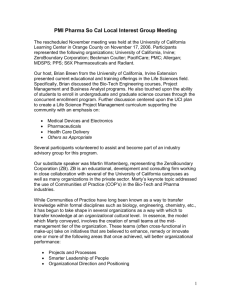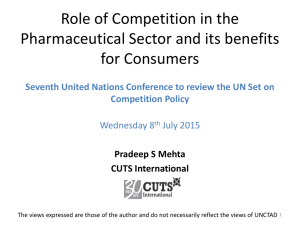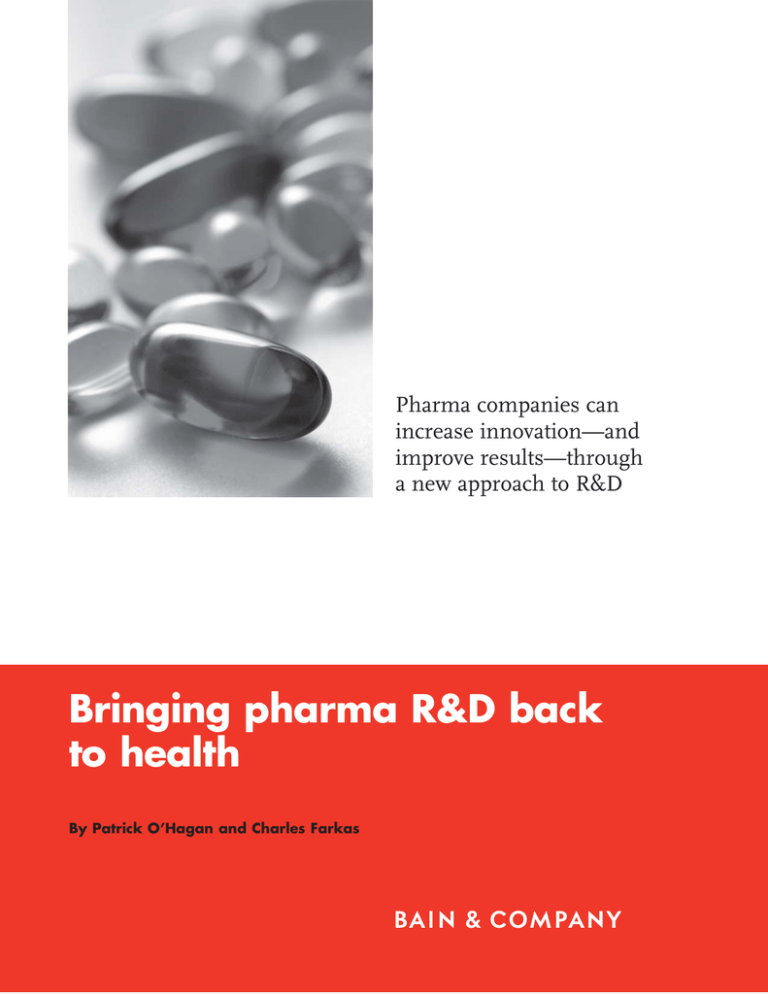
Pharma companies can
increase innovation—and
improve results—through
a new approach to R&D
Bringing pharma R&D back
to health
By Patrick O’Hagan and Charles Farkas
Patrick O’Hagan is a partner with Bain & Company and a leader in the firm’s
Healthcare practice. Charles Farkas is a partner with Bain & Company and
leads Bain’s North American Healthcare practice.
Copyright © 2009 Bain & Company, Inc. All rights reserved.
Content: Manjari Raman, Elaine Cummings
Layout: Global Design
Bringing pharma R&D back to health
The pharma
R&D diagnosis:
Underperforming
It’s no secret that pharma’s traditional approach
to R&D is not working. But exactly how broken is it? Bain’s drug-economics model shows
that the situation is untenable. In the late 1990s,
pharma companies spent $1.1 billion, on average, to develop and launch a new drug. Today,
just a decade later, the investment has doubled to $2.2 billion. (See figure 1.) During
this period, R&D productivity, as measured by
new molecular entities and biologic license
applications per R&D dollar, has declined by
21 percent annually. (See figure 2.) More important, pharma companies have struggled to create
value from their investments in innovation.
The return on invested capital (ROIC) for newdrug development has dropped from 9 percent
in 1995-2000 to an anemic 4 percent today.
Recently, several pharma companies have tried
to resuscitate innovation. They have experimented with new R&D organizations, partnerships and technologies. However, no pharma company has truly transformed the traditional R&D approach. Instead, most still rely
on scale—more is better—to pursue R&D
success. They spend an increasing number of
dollars to fund labs and clinics that generate
stacks of proprietary knowledge about targets,
pathways and compounds. And they still
measure success with scale metrics—typically, the number of “shots on goal” that they
hope will translate into new products.
But this scale-based approach to R&D is
unsustainable. With blockbuster sales slowing
and expected to remain sluggish for the foreseeable future, pharma already feels the economic pinch of weak innovation. Revenues
for the top 15 global pharma companies grew
by a 10 percent CAGR between 2003 and
Figure 1: Cost of developing a drug
Investment required (success adjusted) to launch a pipeline drug
$2.5B
$2.2B
Launch
2.0
1.5
Launch
Phase I
Preclinical
$1.7B
Launch
Phase III/file
$1.1B
1.0
Phase III/file
Phase III/file
Phase II
Phase II
Phase I
Preclinical
Phase II
Phase I
Preclinical
Discovery
Discovery
Discovery
Early 2000s
Today
0.5
0.0
Late 1990s
Launch period
Source: Bain drug economics model, 2008
1
Bringing pharma R&D back to health
Figure 2:
Decline in
R&D productivity
Pharma R&D Productivity
(NMEs*/BLAs**
per $B R&D spend)
1998
2.6
1999
2.1
2000
1.4
2008, but are expected to drop sharply to just
2 percent over the next four years. (See figure 3.)
So, the urgent $60-billion question (the amount
bio-pharma companies spent on R&D in 2007)
facing the industry is this: is there a better
approach to R&D?
Fortunately, the answer is yes. While success
won’t be easy given the magnitude of change
required and the tough business climate—
regulators remain wary of new drugs and payers
question reimbursements—change is possible.
Despite the hurdles, pharma companies can
successfully invest in a new approach to R&D.
Returns-driven R&D: Three
steps away
1.2
2001
2002
0.8
2003
0.8
2004
0.8
The world needs pharma R&D to succeed.
According to the World Health Organization,
heart disease, stroke, cancer, chronic respiratory diseases and diabetes cause more than
60 percent of all deaths worldwide. With major
health problems still unsolved, pharma companies need to prime their innovation pump
and achieve better results.
Step 1: Take the customer’s pulse
2005
0.5
2006
0.5
2007
0.3
CAGR
(98–07)
21%
*NMEs: New molecular entities
**BLAs: Biologic license
applications
Note: NMEs/BLAs approved is
measured 5 years after initial
R&D investment
Source: EvaluatePharma,
FDA CBER website (PDUFA)
2
In R&D, successful results are never guaranteed.
But a number of companies, across industries,
have found that involving customers early in
R&D improves the odds of success. SAP, a
worldwide leader in business software, constantly churns out new products for more than
82,000 customers in 25 industries. In 2007,
SAP invested almost $2 billion—nearly 14
percent of its revenues—in R&D at 13 research
centers around the globe. SAP involves customers very early in the research process by
forming customer advisory boards for each
industry segment. Board members are appointed
for two-year terms, and they include not just
SAP customers but also the competitors’ customers. Board members articulate their needs,
and then SAP aligns its R&D priorities to
match those needs.
Historically, in pharma, customer-led R&D
has not been practiced so rigorously. Pharma
companies set R&D priorities based on the
opportunity for scientific discovery combined
with long-term revenue forecasts—notably,
not profit forecasts—that promise attractive
commercial gains. They seek the customer’s
input—from physicians, payers and patients—
usually only after a product reaches the latestage pipeline; even then, the feedback influences only launch strategies and market positioning. Moreover, such customer input is heavily
focused on physicians, such as the factors that
influence their prescriptions. The payer’s perspective is largely restricted to reimbursement
negotiations. It is rarely an input for setting
R&D priorities, and almost never in the early
stages of the pipeline—in the labs and clinics.
In effect, pharma companies seldom undertake
a rigorous assessment of what payers will be
willing to pay for—compared with alternative
treatments—before deciding what to research.
In the future, pharma companies will need to
listen early in their R&D efforts to the voice of
customers—especially payers. While a pharma company cannot design products tailored
to customer specs, as SAP does, it can guide
its R&D closer to customer needs. That shift is
imperative. As payers consolidate, they are
becoming more powerful and cost conscious,
demanding hard evidence that their reimbursement dollars are well spent. By identifying
which health outcomes payers are more willing
to reimburse, pharma companies can more
closely align R&D priorities with market realities. This new approach will be challenging,
and even a little frustrating, because payer priorities change over time. But pharma companies must listen, respond and evolve based on
what their customers are saying. (See figure 4.)
Bringing pharma R&D back to health
The payoff will be substantial. Pharma companies will have more confidence when funding R&D projects that have passed the payer
test—a rigorous evaluation of the improvements in health outcomes that will be valued
by payers and are likely to earn attractive reimbursement. From the get-go, these projects
will have a greater probability of commercial
success despite the alternative treatments available, budget constraints and changing healthcare priorities. It will also be easier to stop
projects that dip below the bar set by payers,
whether on safety, efficacy, or affordability.
Pharma companies will find this new approach
quite achievable: they already have extensive
relationships with payers, as well as deep knowledge of reimbursement systems around the
world. It’s now a matter of using that payer
input early enough to set research priorities.
Novartis is blazing a trail in that regard. It
underwent a long and arduous process to get
approval in the UK for Lucentis, a wet age-
related macular degeneration treatment. The
UK’s National Institute for Health and Clinical
Excellence (NICE) took two years for an
appraisal, including a legal battle when Novartis
appealed its initial decision. In the end, a risksharing agreement was struck between Novartis
and NICE. But Novartis turned that difficult
experience into a positive one. In December
2007, even as the legal battle waged, Novartis
engaged NICE as a consultant to provide guidance on an upcoming Phase III clinical trial.
The “Novartis 001” pilot ensured that Novartis
designed better studies, assessed economic
value more accurately and laid the groundwork for a smoother NICE appraisal process.
Although final results are pending, both
Novartis and NICE have praised the collaboration, and Novartis is now talking to national
agencies in many countries, including Sweden
and the Netherlands, about similar pilots.
Novartis is actively encouraging payer collaboration. Yet this first step in the new R&D approach
Figure 3: Financial impact from less innovation
Top 15 pharma revenues
CAGR
(08–12)
2%
$600B
CAGR
(03–08)
10%
519
518
2008
2009E
540
562
564
2011E
2012E
483
434
402
400
363
323
200
0
2003
2004
2005
2006
2007
2010E
Note: Top 15 by pharma revenues, not total revenues
Source: EvaluatePharma
3
Bringing pharma R&D back to health
Figure 4: Step 1: Take the customer’s pulse
The old way
100%
The new way
100%
Patients
Payers
80
80
60
60
Providers
40
Patients
Payers
40
20
Providers
20
0
0
Customer input
Timing
Use
Research
Development
Marketing
Customer input
Sales
Launch and market positioning
will require pharma companies to go even further. Successful companies will collaborate with
payers earlier than late-stage clinical trials.
They will expand the dialogue from single
products to a portfolio of products. And they
will broaden the mix of payers to reflect a wider
range of reimbursement options, including
the expanding segment of self-paying patients.
Step 2: Scan for outside innovation
Increasingly, across industries, innovation
springs from diverse sources. As a result,
leading companies are looking outside their
four walls for new ideas to propel growth and
stay ahead of the latest innovations. Procter &
Gamble (P&G), the world’s largest consumer
goods products company with 2008 sales of
more than $83 billion and an R&D budget of
$2.2 billion, realized it had a problem when
its innovation success rate—the percentage of
new products that met financial objectives—
stagnated at about 35 percent. The company
4
Research
Development
R&D priorities and
resource allocation
Marketing
Sales
Launch and
market positioning
prided itself on its R&D prowess—boasting it
had more PhDs than the combined science
faculties at Harvard, MIT and Stanford and
more than 3,800 patents a year to its credit.
But clearly, that was not enough. In 2000,
P&G adopted a bold approach called “Connect +
Develop” to access 50 percent of its innovation
from outside the company. It required a major
shift in attitude from “not invented here” to
“proudly found elsewhere”—and it worked.
Today P&G counts its R&D community as
7,500 engineers and scientists inside the
organization along with seamless access to 1.5
million outside the organization. By 2006, the
company’s innovation success rate had more
than doubled, the R&D budget as a percentage of sales had fallen, and about 45 percent of
the products under development were based
on innovative ideas from outside the company.
Pharma companies, in contrast, too often prefer to look inside their four walls for sources
of innovation. Confident they have the best
Bringing pharma R&D back to health
talent and technology inhouse, they rely on
themselves to generate new products. To be
sure, pharma companies license and acquire a
large number of compounds, but the impetus
usually comes from business development—
often a compulsion to plug gaps in revenue
projections. The net result: the full landscape
of external innovation is seldom fully evaluated
and integrated into pharma’s R&D priorities.
For pharma, it’s time to eliminate that internal
bias. To generate a steady stream of successful
new products, pharma companies must throw
open their doors and bring home outside
innovation. The best scientists always keep
tabs on new science; it’s part of their DNA.
But in this new approach, they need to do
more in three ways. One, they must commit
to constantly scanning the external landscape
with depth and rigor. Two, they must look
beyond what’s familiar because the future of
healthcare will most likely involve a convergence of different treatments. For example,
medical device companies are already testing
new products to treat migraines—currently,
the domain of drug therapy. What stops a
pharma and a medical device company from
jointly conducting a clinical trial on a mix of
drugs and devices to optimize treatment? Third,
and most important, they must act on their
insights regarding external science—including stopping internal projects that rank poorly
against outside research. Pharma’s goal is to
improve health outcomes. In the future, it will
be even more important to be open-minded
about how to get there. (See figure 5.)
Pharma companies can expect significant
benefits from objectively scanning outside
innovation. Internal R&D projects will be more
carefully scrutinized against external alternatives—counter-balancing the cheerleading of
internal project teams. Less good money will
be thrown after bad because “trailing edge”
research projects will be more quickly identified and not as easy to justify. Also, pharma
Figure 5: Step 2: Scan for outside innovation
The old way
External
sourcing
The new way
Internal
sourcing
External
sourcing
Internal
sourcing
Large
molecules
Devices
Large
molecules
Small
molecules
Small
molecules
s
tic
Se
r
vi
ce
s
no
ag
s
Di
Business
development
Core R&D
Core R&D
5
Bringing pharma R&D back to health
companies will be able to double down on the
Step 3: Act on the right numbers
most promising R&D projects, whether internal or external. Resources will flow more to
whichever sources of innovation appear to
have the highest potential for success. This
new approach is a major shift in mindset. But,
it plays to a pharma company’s strength: their
teams of top-caliber scientists who have the
ability to judge external science. Now, it’s time
to act on their judgment, even when it means
choosing the external over the internal.
GlaxoSmithKline (GSK) is embracing such
external innovation. It launched the Center of
Excellence for External Drug Discovery (CEEDD)
to access “best from anywhere science.” By
establishing CEEDD, an independently managed group with a dedicated budget, GSK’s
goal is to put external and internal R&D on
the same footing and make objective choices
about the most-promising products to fund in
late-stage development and commercialization.
Eli Lilly is also tapping external innovation. In
2001, it launched InnoCentive as a whollyowned subsidiary to explore outside solutions
to problems identified by its scientists. Doing
so proved so successful that by 2006 InnoCentive
was spun off as a multi-industry platform to
connect “seekers” of R&D problems to “solvers”
Private equity firms achieve high returns, or
not, based on their ability to make disciplined
investment decisions. The top firms succeed
repeatedly, not randomly, over long time periods by systematically acquiring companies in
specific sectors, increasing their value and exiting at the earliest possible date to achieve their
target returns. Success in this approach comes
because the management team at the private
equity firm is fully aligned on key decisions—
which include not acting when the price is not
right. The tight link between performance and
compensation within the firm reinforces discipline in investment decisions.
Most pharma companies focus on revenues
instead of R&D returns. Revenues are relatively
easier to project—plug in the patient population, market share and product price, and the
formula yields sales. By contrast, projecting
returns is far harder because it requires a
complete accounting of costs—costs that are
sprinkled across separate budgets such as preclinical, clinical, regulatory, manufacturing
and marketing. It also requires considering
opportunity costs: would investing the next
R&D dollar earn a higher return elsewhere?
With little focus on expected relative returns,
pharma companies end up funding undeserving projects too long.
in a virtual marketplace.
GSK and Eli Lilly are making bold moves to
benefit from outside innovation. But to completely embed this second step in the new R&D
approach, a pharma company will need to
open itself up even more. It must constantly
scan outside innovation as a core R&D activity.
It will need to widen the lens to include industries such as devices, diagnostics and services.
Finally, it will have to fully integrate that information into every R&D investment decision.
6
Instead, pharma companies need to employ
the same financial rigor as top-tier private
equity firms. Both manage large portfolios of
assets that must deliver attractive returns over
very long cycles, and for both, discipline in
investing is the key to success. For pharma, it
starts with projecting revenues based on a realistic
set of assumptions, accounting for a marketplace that is increasingly crowded and shaped
by the availability of high quality generics. In
addition, it means calculating total costs based
on the entire length of the project, from the lab
Bringing pharma R&D back to health
to the marketplace. Such analysis of revenues
and costs will yield the expected ROIC and
allow R&D decision makers to fund projects
against the appropriate hurdle rates. Tracking
these hurdles is a constant process: disciplined
funding decisions must be made at the outset,
but also at every major stage to ensure that
dollars are spent only on the most attractive
projects. (See figure 6.)
Pharma companies will reap rewards from such
financial discipline. For one, this new approach
increases the transparency of R&D costs and
puts greater pressure on actively reducing them.
For another, it leads to a more efficient allocation of resources by turning the capital spigot
on and off. In this approach, only the most
deserving—not necessarily the most high-profile—projects get funded. Fortunately, pharma
companies have the necessary financial sophistication to pursue this returns-based approach.
The challenge is calculating the right numbers
and acting on them.
AstraZeneca demonstrated such financial discipline recently. Even though the company
continues to invest in novel ways to treat gastro-esophageal reflux disease (GERD), it
stopped investing in the development of other
gastrointestinal drugs. The problem was not
revenues—Nexium and Prilosec accounted
for more than $6 billion in sales in 2008—
the problem was returns. AstraZeneca felt it
was unlikely to discover new and differentiated drugs in that area compared with existing
therapies. Instead, it could earn better reimbursement in areas like diabetes and obesity.
Using similar logic, Pfizer recently decided to
exit cardiovascular R&D.
AstraZeneca and Pfizer exemplify decision making based on the right numbers. This third step
in the new R&D approach, though, will require
even greater discipline by pharma companies.
They will have to apply stringent ROIC hurdles from the outset. Then, they will have to
reallocate R&D dollars across projects as value
Figure 6: Step 3: Act on the right numbers
The old way
The new way
ROIC
Revenue forecast by product
20%
$1.0B
A
B
C
0.75
D
E
0.50
F
0.25
Revenue
hurdle
0.00
17%
12%
10
9%
8%
5%
5
2%
0
Stop F
ROIC
hurdle
15
A
B
C
D
E
F
Stop B and E
Fix A and F
Doubledown on C and D
7
Bringing pharma R&D back to health
forecasts change. And most important of all:
they will have to set a high bar on expected
ROIC in order to improve the rate of return
from the current lackluster 4 percent.
How to get started
At first sight, focusing single-mindedly on
returns-driven R&D might seem a marked
departure from the past. But in practice, it
builds off existing skills and strengths, and
several pharma companies have already begun
to experiment with aspects of returns-driven
R&D. Fully implementing this new approach
will require careful, sequenced implementation of all three steps. A helpful starting point
for any pharma company is to review the existing pipeline against three filters:
•
Is each R&D project a priority from the
payer’s perspective? To facilitate this exercise, a pharma company can convene a
payer panel and subject each pipeline
compound to its scrutiny. Non-disclosure
agreements will ensure confidentiality
and foster a frank discussion about which
compounds have the most promising
future—as seen through the payer’s eyes.
•
Is each R&D project based on the best available science? This filter requires thoroughly scanning innovation inside and outside
the company. To reduce the burden, the
pharma company should concentrate
only on projects the payer panel found
promising. The goal: to identify projects
with the strongest scientific merit, regardless of source.
•
8
Is each R&D project above the ROIC hurdle?
It’s time to do the math. For all projects
that pass the payer and innovation screens,
project teams need to forecast ROIC—
taking into account realistic assumptions
and total costing. R&D management can
then rank and assess the portfolio.
Pharma managers will be surprised how asking these questions quickly leads to clarifying
the R&D priorities. Even rough answers will
yield a list of potential winners—and laggards.
The pharma company will then be able to stop
or accelerate projects accordingly. It will also
have the opportunity to choose the best plans.
For example, by modifying the designs of its
trials, a pharma company can deliver clinical
data that payers will most value in their reimbursement calculations. R&D leaders will emerge
more informed, focused and energized by
their effort.
However, a pipeline review is only an initial
step. As a follow up, pharma companies will
need to invest in new capabilities. While the
specifics will vary by company, these capabilities could include setting up a global network
of trusted payers to provide input; forming an
innovation team to routinely refresh the widereaching assessments of external innovation;
and creating a financial advisory board to offer
disciplined, outside-in views of investment
opportunities. Along with new capabilities,
pharma companies will need to clarify who
makes decisions. Tough calls are central to
this new approach, but they won’t get made
unless it is clear who has the authority to
make bold returns-driven decisions.
Successfully transitioning to returns-driven
R&D, therefore, will depend on leadership.
The right leaders will need to be both “bench
scientists” and “business scientists”—possessing the confidence and ability to engage payers,
tap outside innovation, and exercise rigorous
financial discipline. In turn, their new behaviors will cascade through the R&D organization and catalyze change at all levels. To be
sure, every step forward will be challenging—
but doing things the old way is no longer an
option. Given the low yield of today’s drug
development, it’s time to breathe life back into
pharma R&D.
Bringing pharma R&D back to health
Bain’s business is helping make companies more valuable.
Founded in 1973 on the principle that consultants must measure their success in terms
of their clients’ financial results, Bain works with top management teams to beat competitors
and generate substantial, lasting financial impact. Our clients have historically outperformed
the stock market by 4:1.
Who we work with
Our clients are typically bold, ambitious business leaders. They have the talent, the will
and the open-mindedness required to succeed. They are not satisfied with the status quo.
What we do
We help companies find where to make their money, make more of it faster and sustain
its growth longer. We help management make the big decisions: on strategy, operations,
technology, mergers and acquisitions and organization. Where appropriate, we work with
them to make it happen.
How we do it
We realize that helping an organization change requires more than just a recommendation.
So we try to put ourselves in our clients’ shoes and focus on practical actions.
For more information, please visit www.bain.com
Amsterdam • Atlanta • Beijing • Boston • Brussels • Buenos Aires • Chicago • Copenhagen • Dallas • Dubai • Düsseldorf • Frankfurt • Helsinki
Hong Kong • Johannesburg • Kyiv • London • Los Angeles • Madrid • Melbourne • Mexico City • Milan • Moscow • Munich • New Delhi
New York • Palo Alto • Paris • Rome • San Francisco • São Paulo • Seoul • Shanghai • Singapore • Stockholm • Sydney • Tokyo • Toronto • Zurich

